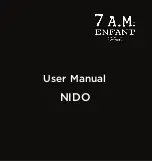
28
7. Install spare tire and wheel onto hub.
8. Reinstall lug nuts and tighten firmly.
9. Drop tire and wheel onto ground after removing supports.
10. Now fully tighten and torque lug nuts at 90 to120 foot pounds.
11. Place all equipment into coach or tow vehicle.
12. Re-torque wheel after traveling 100 miles.
Wheel Bearings
All wheel bearings are pre-lubricated during assembly of axle and brakes.
Your coach may have “ULTRA LUBE” method of having a grease fitting
in the end of axle. Remove rubber cap on end of axle and use standard
grease gun to place grease into bearings, 6 to 8 shots. Repack bearings
as per maintenance manual. Grease in your gun is not true wheel bearing
grease.
Wheel Lugs
When the wheels are installed on your recreational vehicle, the lug nuts
must be tightened at 90-120 foot pounds of torque. Powder coat painted
wheels may require more torque attempts due to thickness of paint. You
must re-torque the wheel lugs at 50 and 200 miles. A decal on the wheel
may require torque earlier.
After your first trip, check the wheel lugs periodically for safety. The wheel
lugs should then be checked after winter storage, before starting a trip or
following extensive braking. Over torque will damage components,
especially if wheel lug torque goes over 150 pounds. Normally the “nut”
fails first however, the embossing on the wheel can also be flattened, and
then fail to keep the wheel tight.
Brakes
—Electrical
Electric brakes on your recreational vehicle are designed to work in
conjunction with the hydraulic brakes on your tow vehicle. This means to
have the best brake performance on both systems, the trailer and the tow
vehicle must perform and operate together. Any attempt to use either
brake system alone, tow vehicle or trailer, will cause accelerated wear
and damage.
A brake control is required to operate the brake system, which is mounted
under dash of tow vehicle, using 12-volt DC power. Each brand has their
own operating instructions.
The battery in the tow vehicle is your primary source to operate the brake
system in a towable trailer. Keep battery and charging system in good
working condition to ensure available power when needed.
Power from battery is sent to the controller, then switch, to provide the
correct amount of current to brake assemblies on the coach. As you press
harder on the brake pedal, more current will flow, applying brakes more,
increasing braking capability.
















































